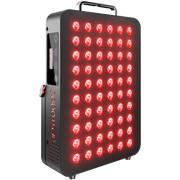As a pioneer of the budding industry, Bestqool is unsparing in its efforts to investigate the latest discovery of red LED light therapy. With its exploratory nature, it is a challenging task to always catch up with new discoveries and research. In this blog, we will exhibit the new advancement in how red and near infrared light therapy interact with the human body and give you a further understanding of LED infrared light and red light therapy.

What is red light therapy?
Red light therapy is a form of phototherapy that uses red light and infrared light to treat various medical conditions. Red LED light therapy is effective because it stimulates the production of natural healing factors in the body. Red light therapy has many benefits, such as treating skin disorders, eye diseases, and inflammation. In terms of skin disorders, red light therapy can eliminate fine lines and wrinkles, brighten skin tone, and improve skin health and appearance. Red and near infrared light therapy is also used to treat various types of eye diseases, including dry-eye syndrome and photophobia (sensitivity to light). The mechanism behind is the activation of photochemical processes through chromophores -- primarily water and cytochrome c oxidase (Cox).

Cytochrome c oxidase (Cox) is the electron transport chain's final enzyme, facilitating electron transfer from cytochrome c to molecular oxygen. Several lines of evidence indicate Cox acts as a profound function to stimulate cellular capacity. Multiple roles of cytochrome c oxidase in mammalian cells under the action of red and NIR light therapy are thoroughly explained in this study. As a photosignal transducer in the red and near infrared range of the light spectrum, photobiomodulation (PBM) appears to enhance the availability of electrons for the combination and utilization of molecular oxygen in the Cox catalytic center, escalating the mitochondrial membrane potential (MMP) as well as the levels of ATP, cAMP, and ROS.
In the electron transfer chain of cellular respiration, PBM light therapy boosts the activity of complexes I, II, III, IV, and succinate dehydrogenase. Cox is known as complex IV and appears to be the major photoreceptor of red and infrared light therapy treatment. This hypothesis is backed by the increase of oxygen consumption under low-level red light therapy and the fact that sodium azide, a Cox inhibitor, reduces PBM light therapy benefits. Aside from ATP and cAMP, nitric oxide (NO) levels are raised, either by discharge from the metal complexes of Cox (Cox contains two heme and two copper cores) or by increasing Cox activity as a nitrite reductase, as described in this study. Actually, it is postulated that PBM red light therapy exerts effects by photodissociating NO from Cox, thereby undoing the inhibition of cellular respiration in mitochondria by the occupation of NO binding.
The action behind infrared red light therapy
The most widely acknowledged biological mechanism of low level LED light therapy is the retrograde mitochondrial signaling in this study. This procedure that happens with visible red infrared light irradiation is illustrated in the pictures. The initial stage is the absorption of a photon with a specific amount of energy hv by the chromophore Cox. This interaction raises mitochondrial membrane potential, which enhances ATP production and increases the amounts of reactive oxygen species (ROS), Ca2+, and NO. In addition, there is message transmission between mitochondria and the nucleus, which is triggered by the modulation of the ultrastructure in the mitochondria, i.e. the variation in the fission-fusion equilibrium of a dynamic mitochondrial network. Variations in mitochondrial ultrastructure lead to the alteration in ATP generation, intracellular redox potential, pH, and cyclic adenosine monophosphate (cAMP) levels. Alterations in membrane permeability and ion flow at the cell membrane induce changes in the activity of activator protein-1 (AP1) and NF-B. Through such regulation of transcription factor, red light therapy treatment has a direct upregulation of some genes expression.

Kappa B nuclear factor (NFkB) is a transcription factor that has a charge over the expression of several genes involved in a variety of cellular processes, including inflammatory and stress-induced responses, as well as cell survival. Its activity is controlled by a negative feedback loop intermediated by an inhibitor, i.e. IκB, which binds to NF-B to inactivate it or can be ubiquitinated and degraded by proteasomes to release NF-B. The transcription factor is subsequently translocated to the nucleus, where it helps gene transcription. It is confirmed that NF-B is redox-sensitive, due to the fact that the levels of ROS directly has a direct impact on the activation of NF-B via TNF, IL-1, and phorbol esters, as being studied in this research. Photobiomodulation red light therapy has been proven to increase temporal ROS production, whereas red light therapy effectiveness for stimulating NF-κB activation is also demonstrated.

Bestqool red light therapy near me

Clinic red light therapy is the latest advancement that shows many promising results on a variety of medical conditions. This therapeutic red light therapy has been applied in many clinical trials, and as the only discovery of the non-invasive and effective treatment for mediating at a cellular level, the benefits of red and infrared light therapy present a prosperous future of medical applications.
It is Bestqool’s goal that aims at delivering the best red light therapy at home to meet the standards of medical treatments. Bestqool is proud of being able to produce the best at home red light therapy devices that are both effective and guaranteed by the highest safety standards. As true FDA-approved red light therapy devices, Bestqool devices are based on the results of medical research and clinical trials, to apply the most effective and superior optical choices.
All Bestqool devices are designed by the advanced LED technology which can meet the needs of therapeutic purposes, including the laser-like concentration of specific wavelengths (830nm infrared light and 660nm red light), efficient energy consumption, and the highest potential of light irradiance with the cooling system. It is noteworthy that irradiance level and wavelength concentration determine the efficacy of light therapy, as only true medical LED light therapy devices can achieve the optical standards and safety principles of red light photodynamic therapy. Using 10 minutes of Bestqool is just as effective as using 20 minutes of the products of others.
To best guarantee the at home experiences of NIR and red light therapy, all Bestqool products come with a three-year warranty, the longest promise in this market.













 Small
Small

 Moderate
Moderate

 Moderate
Moderate

 Moderate
Moderate

 Full
Full



